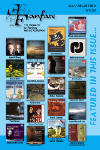Texte paru dans: / Appeared in: |
|||||||
|
Reviewer: Lynn
René Bayley
“The Belgian music director and viola da gamba player, Philippe Pierlot, studied guitar and lute. Later he decided to concentrate entirely on the viola da gamba. Pierlot directs the Ricercar Consort ensemble with whom he interprets mostly works of the 17th century, revealing unknown compositions to the public. Several contemporary pieces were written for him, and he is also one of the rare ‘baryton’ players, a very peculiar instrument for which Haydn wrote more than 150 trios and other pieces…Pierlot is frequently invited to take the direction of important works which he restores or adapts. For example, in 1999, Marais’s Sémélé, which had not been performed for 300 years, and for which he recomposed the missing instrumental parts.” FYI, this particular configuration of players is not the Ricerar Consort, which judging by their photos consists of six to eight musicians including two women, but some of these musicians may indeed be current members of that group. I still haven’t uncovered this info. As for descriptions of Marais’s music, rather that eat up valuable publication space I will simply refer the reader to allmusic.com/composition/couplets-de-folies-les-folies-despagne-for-viola-da-gamba-continuo-in-d-minor-pi%C3%A8ces-de-viole-book-ii-no-20-mc0002361002/complete. Enjoy your visit. Now, at last, we reach the performances. They have, to my ears, an extraordinarily odd sound. Yes, the phrasing is fluid, which I normally like, and not the clipped cut-and-dry style of the Anglo-Saxon or German schools of early music which I do not. But for me there’s something a bit “whiny” about it, not as if they were playing period instruments here in the 21st century but had picked up some decaying, archaic instruments in a museum, somehow got them in tune, and then had a go at the music—in other words, they have a “musty” sound. For the sake of accuracy, it should be pointed out that both Pierlot and his colleague Zipperling are playing the seven-string bass viola da gamba, which first appeared in France (presumably invented by a woman, named online simply as “Ms. Columbe”) in the late 17th century, and not the standard six-string instrument. This seventh string was pitched a fourth down from the sixth, keeping the same relationship of fourths all the way up (or down) on the instrument from string to string (ref: thecipher.com/viola_da_gamba_cipher-2.html). As to the music, it is indeed interesting and highly inventive for its time and place. No question about it, Marais was a fine composer, it shows in these works, and these four players are quite obviously virtuosos of their instruments. Tricky technical passages fly under their fingers without incident, and they sound is if they could play these in their sleep. They also have a splendid energy in the fast passages. But oh, those slow pieces! To be fair, I think the microphone placement has a lot to do with it. The instruments sound, to my ears, muffled and distorted, and I find it difficult to believe that virtuosos of this high a level would actually produce a sound this poor on their instruments; but there you have it. Thus, from the standpoint of the music, a thumbs up, but from the standpoint of a listening experience, a thumbs down. | |||||||
|
|||||||
|
|
|
||||||
|
Cliquez l'un ou l'autre
bouton pour découvrir bien d'autres critiques de CD |
|||||||




